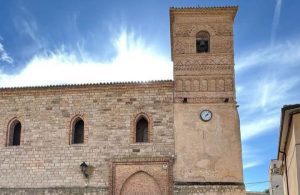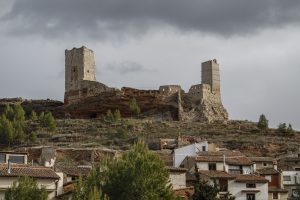
Circular from
the rural school
The “Circular from the rural school” project is a cooperation project between rural development groups led by the Asociación Territorio Mudéjar.
The following have participated in the project: ADRI Calatayud-Aranda, ADRI Jiloca-Gallocanta, FEDIVALCA -Valdejalón and Campo de Cariñena-, ASOMO Tarazona and el Moncayo, CEDEMAR -Bajo Aragón Caspe and Ribera Baja del Ebro-, ADRAE -Ribera Alta del Ebro- and ADEFO Cinco Villas.
The objective is to develop educational materials around the Mudejar identity of the towns, placing rural schools and the educational community of the towns as the center of the project.
Based on the work developed, for almost three years, the students of fifteen schools have designed a walk through their town in which we can learn about the main points of interest and their connection with the Mudejar culture.

Alagón
The town belongs to the ADRAE local development group that brings together the towns of the Ribera Alta del Ebro region.
The tour has been carried out following the work model of the schools that participated in the project and adapted to the town of Alagón.
Alagón is located between the Aragón channel and the Jalón and Ebro rivers. The richness of its lands favored the settlement of different cultures throughout its history, such as Christians, Jews and Muslims. Its important history is reflected in its urban layout, where traces of what was the Moorish quarter and the Jewish quarter are still preserved. In Alagón you will also find buildings such as the hermitage of Nuestra Señora del Castillo or the church of San Antonio de Padua. Although, without a doubt, the jewel of the town is the Mudejar church of San Pedro, with its magnificent tower.

1. History of the town
In Alagón we find very old human settlements. An example is Alaún, an Iberian town that had its own currency. In the same place rise the remains of an old Muslim castle, around which the town was created and developed. Today in this place we find the hermitage of Nuestra Señora del Castillo, built in the 16th century.
This point is linked to the didactic activity 1

2. Mudejar architecture
Mudejar architecture is developed by the Islamic population that remained in the territory after the Christian conquest and which came to be called Mudejar. The Mudejars were especially skilled in the construction trades. This fact is perfectly appreciated in the church of San Pedro and its tower. The building witnessed various very important historical events, such as the wedding of the Aragonese King Pedro IV with his first wife, María de Navarra, in 1338.
This point is linked to the didactic activity 5

3. Construction materials
In Alagón, as in other towns, we can see those materials used for Mudejar monuments, adapted for housing. For this reason, the conservation of traditional architecture is important, since it allows us to know how these buildings are made, as well as the monumental ones. These construction techniques derive from the Islamic tradition and the use of the land for the realization of brick, adobe and wall.
This point is linked to the didactic activity 3

4. Coexistence of cultures
During medieval times, 3 cultures coexisted in our territory: Christians, Jews and Muslims. Under the power of the Christian quarter, we find Jewish quarters and morerías. These spaces are the neighborhoods or aljamas where each culture was organized, with spaces for worship as well as places for social gatherings (market squares).
This point is linked to the didactic activity 2

5. Reminiscencias
The elements and materials, as well as construction techniques of the Islamic tradition, have continued to be used over time, but adapted to other architectural languages, such as the Renaissance palaces that are preserved in Alagón.
This point is linked to the didactic activity 7
The project has been carried out thanks to the Rural Development Program (PDR) of Aragon 2014-2020 in the call for aid for the preparation and implementation of cooperation projects between local action groups, for the 2019 financial year.








